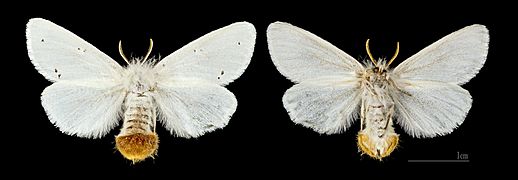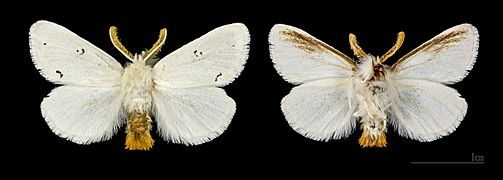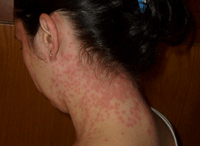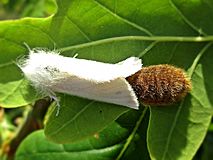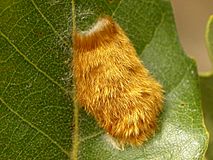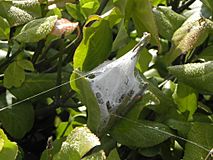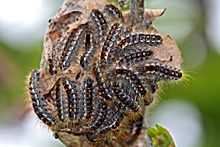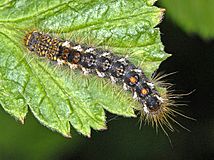Brown-tail moth facts for kids
Quick facts for kids Euproctis chrysorrhoea |
|
|---|---|
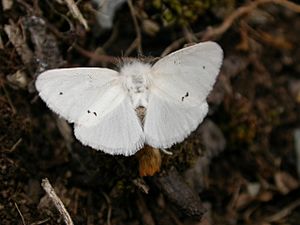 |
|
| Upperside | |
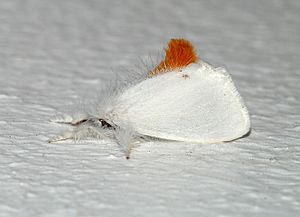 |
|
| Female with tail tuft of red/brown hairs | |
| Scientific classification |
The brown-tail moth (Euproctis chrysorrhoea) is a type of moth found in Europe, parts of Asia, and North Africa. People have reported large increases in their numbers, called outbreaks, since the 1500s.
This moth has a special life cycle. It spends about nine months (from August to April) as a caterpillar. Then it spends about one month as a pupa, one month as an adult moth, and one month as eggs. The caterpillars are covered in tiny hairs. You can tell them apart from other hairy caterpillars by two red spots near their tail. Adult moths have white wings and a white, hairy body. Females have a tuft of brown hair at the end of their body. They lay their eggs in a cluster, usually on the underside of a leaf. These moths are polyphagous, which means they eat leaves from many different trees, like pear, apple, maple, and oak.
The brown-tail moth accidentally came to the United States in the 1890s. By the early 1900s, it was found from Connecticut to Canada. However, its numbers later dropped a lot, and it was mostly found only in coastal Maine and Cape Cod, Massachusetts. Scientists think this decline might have been because of a special fly that was brought in to control another moth. But since 2015, the brown-tail moth population has grown again in coastal Maine. Even though there are many natural enemies in Europe, outbreaks still happen there.
The hairs from the caterpillars can be harmful to humans. They can cause an itchy rash, similar to poison ivy, that can last for weeks. You don't even need to touch the caterpillars directly, because their hairs can fall off and be carried by the wind. These tiny hairs can stay harmful for up to three years. You can get exposed to them during outdoor activities like mowing the lawn or raking leaves in the fall.
Contents
What Does the Brown-Tail Moth Look Like?
The adult brown-tail moth has pure white wings. Males might have some brown color under their front wings. Their wings can spread about 36 to 42 millimeters wide. The moth's body is very hairy and white, except for its tail. The tail is covered in reddish-brown hairs, which are much easier to see on females. Male moths have bigger antennae, which they use to find females by sensing special chemicals called pheromones. Females have a larger body than males.
Adult brown-tail moths look a bit like other moths, such as the yellow-tail moth (from Europe) and the fall webworm (from North America). However, female yellow-tail moths have a yellow tail tuft, and fall webworms don't have any colored tail tuft.
The female moth lays one cluster of about 200 to 400 eggs. She usually places them on the underside of a leaf. She covers the egg cluster with hairs from her own tail to protect them. The caterpillar is very hairy and brown with white markings. It has two clear red spots near its tail, which helps identify it. These hairs also protect the caterpillar from animals that might want to eat it. The caterpillar even uses some of its hairs to build its cocoon when it's time to change into a moth.
These moths spend the winter together as caterpillars inside a strong, silky tent. They build these tents around leaves at the tips of branches and attach them to twigs. If there are many brown-tail moths in an area, you can easily spot these tents, especially in late fall and winter after other leaves have fallen.
Where Do Brown-Tail Moths Live?
Native Homes
You can find the brown-tail moth all over Europe, except in the very northern countries. They also live in western parts of Asia, like Turkey, Syria, and Israel, and along the northern coast of Africa. People have written about brown-tail moth outbreaks since the 1500s. These outbreaks were so bad in cities like Paris, London, and Berlin that they stripped all the leaves from trees. The famous scientist Carl Linnaeus first described this species in 1758.
Invading New Places
The brown-tail moth is an invasive species in the United States and Canada. It first arrived in Somerville, Massachusetts, around 1890 and quickly spread. At first, they caused a lot of damage to pear and apple trees. Doctors reported that the skin rashes caused by the caterpillars were much worse than poison ivy. Within a few years, it became a serious problem for gardens, farms, and public health.
By the early 1900s, it was found across much of New England, from eastern Connecticut to Maine, and up into New Brunswick, Canada. However, in 1906, a parasitic fly was brought in to fight another invasive moth. This fly also affected brown-tail moths, causing their numbers to drop. By the late 1900s, they were mostly found only along the coast and islands of Maine, and parts of Cape Cod, Massachusetts. Cold and wet weather usually stops them from spreading further. But since 2015, their population has grown and spread again in coastal Maine. Besides North America, there have also been reports of this moth appearing in China, Japan, and New Guinea.
How We Find Them
Scientists use aerial photos (pictures taken from planes) to find areas where trees have lost their leaves and where the winter tents are present. They have also created a synthetic version of the female moth's sex hormone. This hormone is used in moth traps to monitor how many moths are flying around in June and July. Adult moths fly at night and are strongly attracted to light. In 1903, someone described them around streetlights as looking like a heavy snowfall!
Life Cycle of the Brown-Tail Moth
The brown-tail moth has one generation each year. It goes through four stages: egg, larva (caterpillar), pupa, and adult. Eggs are laid in July and hatch in August. The whole cycle takes about a year:
- Eggs: They spend about one month as eggs. They prefer to lay eggs on oak trees.
- Young Caterpillars: They hatch in August and start eating together in groups.
- Wintering Caterpillars: As days get shorter in the fall, the caterpillars build their communal winter nests. They stay inside these nests during the winter. These nests are made of silk that binds leaves together at the tips of tree branches.
- Spring Caterpillars: In early April, the caterpillars, which are about one centimeter long, wake up and start eating again as tree buds open. They still use their winter nests as resting places or build new communal nests. These small caterpillars can also fall from trees and look for new ones.
- Spreading Caterpillars: Once the caterpillars grow larger, their groups break up, and they start feeding on their own.
- Pupation: The caterpillars turn into pupae in June.
- Adult Moths: Adult moths appear about one month later. They mate, lay eggs, and then die.
Natural Enemies and Diseases
In the United States, many birds, like English house sparrows and blue jays, eat the adult moths. In Europe, brown-tail moths often have population outbreaks that last several years, followed by a decline. Studies in England found that eggs, caterpillars, and pupae died due to various parasites, viruses, and birds. Birds like the common cuckoo and titmice were specifically mentioned. A study in Spain found 17 types of parasites, viral diseases, and other unknown causes of death for the moths.
A parasitic fly called Compsilura concinnata can lay its own larvae inside brown-tail moth caterpillars. This fly was brought to North America in 1906 to control the gypsy moth. While it didn't completely solve the gypsy moth problem, it had a big impact on brown-tail moths. This is because the fly larvae need to spend the winter inside a host caterpillar, and brown-tail moths overwinter as caterpillars (while gypsy moths overwinter as eggs).
How to Control Them
You can clip off the branch-tip webs in winter and early spring. Then, you can drop them into a bucket of soapy water or burn them. Always wear gloves when doing this!
It's best to apply special sprays before early May. This is when the caterpillars start to develop their harmful hairs. For organic gardens and farms, there are sprays that use a type of bacteria called Bacillus thuringiensis (Bt).
Health Issues from Brown-Tail Moths
The hairs from brown-tail moth caterpillars can cause very itchy rashes when they touch your skin. They can also cause breathing problems, similar to asthma, if you breathe them in. These rashes can last for several weeks. People have reported these symptoms since at least 1903.
The rash happens because of two things: the hairs are barbed and get stuck in your skin, causing physical irritation. Also, the hairs contain irritating chemicals. This type of rash caused by moths and butterflies is sometimes called lepidopterism.
You should always wear protective gloves if you need to handle brown-tail moths at any stage of their life. The shed hairs can blow around and even be carried indoors on clothes and shoes. So, you can get a rash without directly touching the caterpillars. The toxins in the hairs can stay harmful for up to three years after they are shed. Activities like mowing the lawn or raking leaves in the fall can expose you to these hairs.
Other types of Euproctis moths, like the mistletoe browntail moth in Australia, also cause similar rashes in humans. Many other moth and butterfly caterpillars also have hairs that can cause itching and rashes.
What Plants Do They Eat?
Brown-tail moth caterpillars have been seen eating leaves from 26 different types of trees and shrubs that are not resinous. This is unusual because they eat so many different plants. Because they eat so many different plants and can have huge population outbreaks, they are a big problem for fruit orchards, decorative trees, and hardwood forests.
Here is a partial list of plants they eat:
- Apple
- Cherry
- Beach plum
- Beech
- Elm
- Grape
- Hops
- Maple
- Oak
- Pear
- Raspberry
- Rose
- Willow
When the moths first arrived in the United States in the 1890s, they mostly attacked pear and apple trees. But once those trees had no leaves left, the caterpillars would come down to the ground and move towards any leafy plant, even vegetable plants.
Gallery
See also
 In Spanish: Mariposa lagarta cola parda para niños
In Spanish: Mariposa lagarta cola parda para niños



